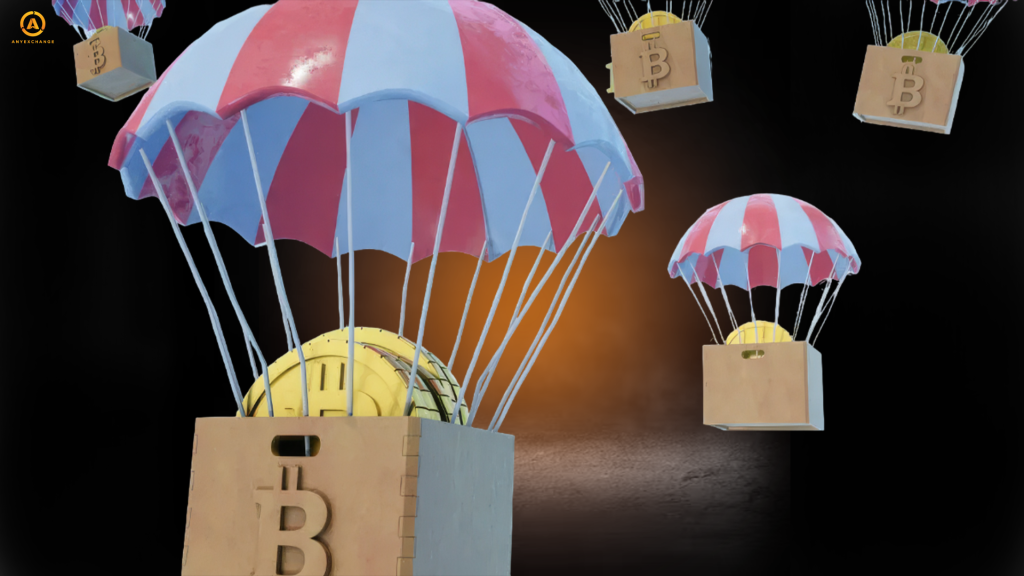
Airdrops primarily attract those who want to enter the world of cryptocurrencies, but do not know where to start. With the help of this tool, even beginners can learn the principles of token circulation and get into the basics of passive income and trading without any special financial risks or no investment at all.
From this article you will learn what airdrops are, what should be taken into account when selecting a project, who are drophunters and what is the situation with cryptocurrency airdrops in 2024.
Airdrops and the cryptocurrency community
Interest in airdrops remains very resilient. According to CoinGecko data, over the past 3 years, DeFi projects have given away about $30 billion worth of assets as part of 50 airdrop campaigns. Analysts estimate that airdrops are conducted by 10-15% of new blockchain startups. Such campaigns attract special attention when large and proven projects announce the imminent distribution of tokens.
An airdrop is a free distribution of a certain number of tokens within a certain period of time to users who perform certain actions in favor of the project. The conditions of airdrops can be very different. Their main objectives are to promote the product and attract new users, as well as to increase the activity and loyalty of existing network members.
What are the airdrops for?
In addition to the above-mentioned marketing tasks, we can also note the following goals pursued by projects:
What is required to enter?
Basic requirements may inсlude:
Next, you need to perform the actions required of users participating in airdrop and confirm that the conditions are met. After some time, the earned tokens will be credited to the specified cryptocurrency wallet.
What you need to do to participate
Airdrop as an engagement tool presents different conditions to participants. Here are some examples:
Criteria that increase the chances of success inсlude:
How to choose airdrops
First of all, follow the rules of information hygiene and security. Study announcements on reputable aggregator platforms (specialized platforms for tracking airdrops provide detailed information about the distribution conditions and the project itself). Some of the most popular and proven platforms are Airdrop King, Airdrops.one, Airdrop Alert, Airdrops.io, Incrypted. As an additional source of information you can use profile channels in social networks.
Pros and cons of Airdrops

Pros
Cons
What kind of numbers we are talking about
The order of reward amounts at airdrops of successful projects for lucky participants looks inspiring:
What you should pay attention to when choosing airdrop

- Only trust information about airdrops from reliable sources. sеlect and use trusted sites to track new airdrops.
- Study the product. Make sure the project has been created by a real team, is backed by investors, and has plans for stable development. Then you can count on the token’s price growth. The ideal choice will be an already launched and successfully functioning product that does not yet have its own token.
- Read the terms and conditions carefully. They should be clear and unambiguous. Because of unclear wording, participants may not get the result they originally hoped for. Also, any unfulfilled condition may disqualify you from receiving tokens.
- Make sure that Airdrop does not ask you for personal information that you do not want to share.
How to avoid scams

Scammers actively exploit the hype leading up to major airdrops. And they do it very professionally. It is telling that not only beginners but also professionals fall victim to them: for example, the CEO of the Nest project (focused on wallet security) Bill Lu fell victim to scammers after losing about $125,000 by “participating” in the LFG airdrop.
There are many variations of fraudulent schemes. The most common are scenarios where the user is asked at the registration stage to:
Strategies to maximize the benefits of airdrops
Airdrops can hardly be considered as a way to make a steady income for beginners. Rather, it is a way to get seed money in cryptocurrency and gain knowledge and experience. However, for some users, giving away free tokens is a job that provides a very good income.
Drop hunters have made participating in free token giveaways their profession. Automating their participation in airdrops allows them to receive rewards from multiple projects and many wallets at the same time, using the principle of “multi-accounting” (managing a large number of accounts). Multi-accounting is considered a threat and fraud by project teams. They call this type of activity “Sibyl’s Attack” and try to fight it with all available means. According to research data, the average income of a multi-account hacker in the middle of last year was at least $10,000. As a result of the Sybil attack, drophunters received 48% of the total tokens distributed by Arbitrum and about 40% of the TIA tokens distributed for free by Selestia. So automating processes and efficiently managing an airdrop portfolio is undeniably a way to generate more revenue. And the more virtuoso drophunters create the appearance of “healthy” activity on the sites, the less likely their actions will be detected by the vigilant project team during the ongoing airdrop security check. And at this point, it’s hard to argue that the developers are winning this contest.
Conclusion
The influence of airdrops on project marketing policy remains strong, with many different airdrops planned for 2024. Among the most anticipated are the upcoming airdrops of the web-3 protocol LayerZero, the zero-disclosure layer-2 protocols zk-Sync and Scroll, and the Base protocol.
The future of airdrops in crypto looks bright at the moment, especially if projects manage to balance the influence of “easy money hunters” on decentralization and token value. Most likely, the market will tighten up methods to combat drophunters, by more closely monitoring links between addresses to identify potential Sybil attacks, and by making the requirements for participants more difficult.
Either way, airdrops are a useful tool for entering the cryptocurrency world and diversifying your existing portfolio. Use trusted sources of information, analyze the value of upcoming airdrops, study the risks associated with them and go for it!
Thank you for your attention!
AnyExchange is an exchanger through which you can buy or sell cryptocurrencies at the best exchange rate . Money transfers are also available on our site worldwide.





